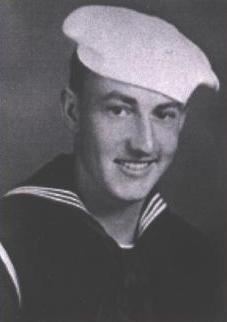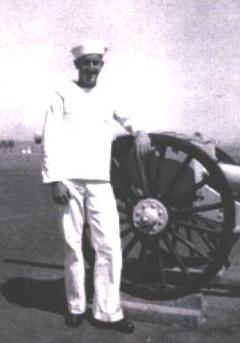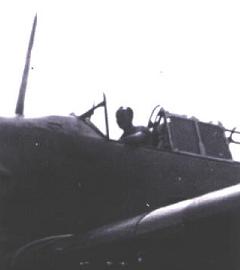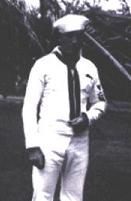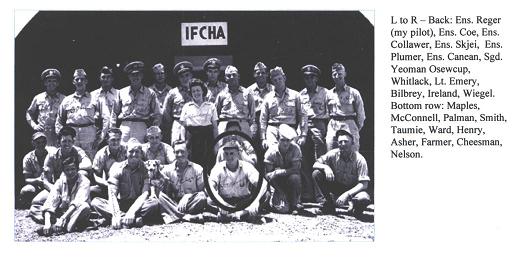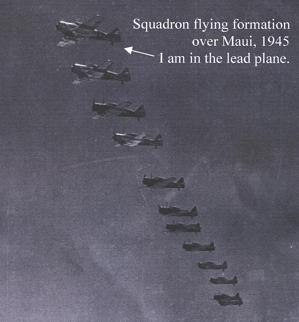Dewey Duane Farmer US Navy Ford Island |
I joined the Navy on July 7, 1940, my last year of High School. My first year was spent at the US Navy Air Base, San Diego, California, first Boot Camp and then going to Air Force Aerial Gunnery School and Radio School. After one year, I was transferred to VP-13 (PBY's) patrol bombers and was scheduled to go to Alaska. The last, my orders were changed and I was sent to the US Navy Air Base, Ford Island, Pearl Harbor, Hawaii. I was at Ford Island when the Japanese attacked us on December 7, 1941 at 7:55 a.m. We were standing at attention for mustering on that Sunday morning. Some were planning a day of leave in Honolulu; others of us were on duty. The attack was sudden and most of our planes were destroyed on the ground. A very few were saved by putting them in the hangars. I was close enough that I saw the Japanese planes torpedo the USS Arizona battleship. At 8:40 a.m. the second wave of Japanese planes struck Pearl Harbor. Gun crews on all ships then started firing. Chaplain Howell Forgey, aboard the USS New Orleans walked among them telling them to "Praise the Lord and Pass the Ammunition". The Battleship California was hit in the fantail (aft) and the rear of the ship sank in 30 feet of water. The USS Utah was a target ship for us when we practiced dive-bombing it with fake smoke bombs. The ship was on the other side of Ford Island. When this ship was sunk, it rolled over and the bottom of the ship was above water. The nights of December 7th and 8th, we in the Navy Air Force were issued Thompson Submachine guns. One hundred fifty of us were stationed twenty feet apart at the mouth of Pearl Harbor as a suicide squad in case the Japanese tried to come in the mouth (entrance to Pearl Harbor). A two-man Japanese submarine came in and a Navy destroyer in the Harbor rammed it and sank it. I saw this happen. I was about 400 yards away. We stayed in this area for two and one half days. Three weeks later the Aircraft Carrier Saratoga came in and brought us new planes. This was when I went into the advanced aviation maintenance, gunnery, radioman and aircrewman training school at the Chicago Trade School that had been taken over by the Navy. I then went back into the Pacific and had 900 hours of combat flying. I was in two plane crashed and walked away from each with just bruises. I trained as air cover for the 3rd and 6th Marine division invasion forces. The ships I can remember that were sunk or damaged at Pearl Harbor were the Shaw (destroyer), the Oglala, the Helena, the Oklahoma, the Maryland, the West Virginia, the Nevada, the Arizona, the Tennessee, the California, the Neosho, the Raleigh, the Curtiss, and the Utah. The main officers in charge at Pearl Harbor were Admirals John Stark and Kimmel. I was in the Battle of Midway in June, 1942, just seven months after the attack on Pearl Harbor. This was the turning point and beginning of Naval dominance in the Pacific. Prior to the Battle of Midway, I was a replacement crewmember stationed with Fleet Air Wing 2, Kaneohe Bay Naval Air Station, Hawaiian Islands. I arrived at Midway during the first battle in a Navy PBY Patrol plane with other relief crewmembers, pilots, gunners, etc. I picked up my plane there and was in on the sinking of the fourth Japanese aircraft carrier. I made one carrier landing on the Enterprise for refueling and armament. I remember the Japanese carriers as the Akagi, Kaga, Soryu, and Hiryu. I served under Admirals Fletcher and Spraunce until after the Battle of Midway. Returning to the US Navy Base at Kaneohe Bay, Oahu, Hawaii, then to the US Navy Air Base, Maui, Hawaii. June 19, 1944, I was in on the bombing of Tinian, Siapan, and Mariannes Group of Islands. We paved the way for the Marines to land. I was on the USS Enterprise aircraft carrier. October 28, 1944 to November 1,, 1944, we raided Truk Island, which was held by the Japanese, and a Japanese Navy base on these two dates. (I may be off a day or two). We sank 30 ships in the Truk Harbor. We were three days behind the Japanese main fleet. We only sank merchant and supply tanks and one Japanese destroyer. I later returned to the Hawaiian Islands for R&R. I was at the US Navy Air Station on Maui Island Hawaiian group when the Japanese surrendered. Upon my return from Midway, I was assigned an aircrew squadron as a plane captain. The squadron was made up of young reserve pilots. The squadron was called I.F.C.H.A. (Instrument Flying Center Hawaiian Area). We would fly to all the Navy airfields in the Hawaiian Islands and train Navy carrier pilots for instrument recognition, as the Hawaiian Islands were similar to the islands in and around Japan. There was a canvas canopy that the pilot pulled up from in back of him and this blocked his outside vision so he had to fly by instruments. We always knew when the carriers were getting ready to exchange air groups aboard the carriers because of the pilots and crews needing a rest. We would get orders to fly to different Navy airfields to train new pilots and we would fly seven days a week. This was a pretty good indication. During my tour of duty with IFCHA, waiting to be reassigned to a carrier or other island we had Navy bombings and torpedo squadrons stop over in the islands on their way to a Japan area. Some of their gunners would become sick and have to be replaced. Fleet Air Wing would ask for single volunteers and if there would be enough they would not have to order some one to go. Volunteers had to be single! The first squadron was the Octopus Squadron, twin engine Vega Ventures, light Navy bombers. They fired a 20 or 40 millimeter canon out its nose. The top gun turret included: a 360-degree turret that fired twin 50 caliber, 5 crew members, pilot, co-pilot; navigator; radioman and two enlisted men gunners. The top turret was painted to look like the head of an Octopus, and then its legs went around the body of the plane. I volunteered for a top turret spot but was turned down. We had a PBY squadron come into Kaneohe Bay Naval Air Station. These planes were all painted black. They had bomb racks under each wing to carry a 1,800-pound torpedo. They were to fly at night and come in about 100 feet over the water and torpedo Japanese ships at sea and in the harbors. This squadron had the same problemshort of gunners. I volunteered again and was turned down again. I think my squadron commander kept me from going. Three months later, the remains of the Octopus Squadron came back. They lost 15 planes out of 18. I understand they did a lot of damage to Japanese troops, fuel storage and ammunition dumps, but they lost 15 planes, all crews dead. The Black Cat squadron came back a month or two later with only half of their planes. I lost a good friend in one of those planes. It just wasn't my time to go. I stayed on the Islands for one year after the war. We ended up with lots of planes and no pilots. Pilots were to be let out of the Navymost of the pilots were reserves. I became a Navy Taxi Pilot, transferring planes around on the basesgetting them ready to be returned to the states and dismantled, or we would dismantle them and put them in crates. I was released from the Navy on July 7, 1946 at Goat Island, San Francisco, California. |
Information provided by Dewey Duane Farmer. |
